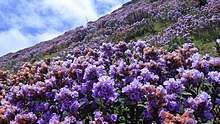Strobilanthes kunthiana
Strobilanthes kunthiana, kurinji or neelakurinji, is a shrub that is found in the shola forests of the Western Ghats in South India. Nilgiri Hills, which literally means the blue mountains, got their name from the purplish blue flowers of Neelakurinji that blossoms only once in 12 years. Of all long interval bloomers (or plietesials) Strobilanthes kunthiana is the most rigorously demonstrated, with documented bloomings in 1838, 1850, 1862, 1874, 1886, 1898, 1910, 1922, 1934, 1946, 1958, 1970,[1] 1982, 1994, 2006 and 2018, these have no match to Solar cycles.
| Strobilanthes kunthiana | |
|---|---|
 | |
| Scientific classification | |
| Kingdom: | Plantae |
| Clade: | Tracheophytes |
| Clade: | Angiosperms |
| Clade: | Eudicots |
| Clade: | Asterids |
| Order: | Lamiales |
| Family: | Acanthaceae |
| Genus: | Strobilanthes |
| Species: | S. kunthiana |
| Binomial name | |
| Strobilanthes kunthiana (Wall. ex Nees) T. Anders. ex Benth. | |
Other kurinji species, such as Strobilanthes cuspidatus, bloom once every seven years, and then die. Their seeds subsequently sprout and continue the cycle of life and death.[2]
The Paliyan tribal people living in Tamil Nadu used it as a reference to calculate their age.[3] This plant flowers during September-October.
Description
Kurinji grows at an altitude of 1300 to 2400 metres. The plant is usually 30 to 60 cm high. They can, however, grow well beyond 180 cm under congenial conditions.[4]
The kurinji plant belongs to the genus Strobilanthes which was first scientifically described by Christian Gottfried Daniel Nees von Esenbeck in the 19th century. The genus has around 250 species, of which at least 46 are found in India. Most of these species show an unusual flowering behavior, varying from annual to 16-year blooming cycles.[5]
Plants that bloom at long intervals like Strobilanthes kunthiana are known as plietesials. Other commonly used expressions or terms which apply to part or all of the plietesial life history include gregarious flowering, mast seeding and supra-annual synchronized semelparity (semelparity = monocarpy).[6]

Masting
Some species of Strobilanthes are examples of a mass seeding phenomenon termed as masting[7] which can be defined as "synchronous production of seed at long intervals by a population of plants".[8] Strict masting only occurs in species that are monocarpic (or semelparous) -- individuals of the species only reproduce once during their lifetime, then die,[9] as is the case with Strobilanthes kunthiana.
Habitat
Kurinji once used to cover the Anamalai Hills, Cardamom Hills, Nilgiri Hills, Palani Hills and Bababudangiri like a carpet during its flowering season. Now plantations and dwellings occupy much of their habitat. Neelakurinji also bloomed in Chandra Drona Hill Ranges (Bababudan Giri) in Chikkamagaluru district of Karnataka in 2006. The whole of Bababudangiri Hills(Datta Peeta) were covered in a carpet of bluish purple flowers. It is expected to bloom again in 2018[10] Besides the Western Ghats, Neelakurinji is also seen in the Shevroys in the Eastern Ghats, Anamalai hills Idukki district and Agali hills in Palakad in Kerala and Sanduru hills of Bellary district in Karnataka.
In 2006, Neelakurunji flowered again in Kerala and Tamil Nadu after a gap of 12 years. Thereafter, the Strobilanthes cuspidatus species of kurinji flowers were found blooming in 2016 in Udhagamandalam near a major road.
In 2017, Neelakurinji flowers bloomed in the hills behind Kumaraswamy temple in Sanduru, Bellary district.[11]
Conservation
Kurinjimala Sanctuary protects the kurinji in approximately 32 km² core habitat in Kottakamboor and Vattavada villages in Idukki district of Kerala. The Save Kurinji Campaign Council organizes campaigns and, programs for conservation of the Kurinji plant and its habit.[4] Kurinji Andavar temple located in Kodaikanal on Tamil Nadu dedicated to Hindu God Kartikeya also preserves Strobilanthes plants.
References in literature
Kurinji flower is used to describe the associated mountainous landscape where it blooms in classical Tamil literature. The historical novel, Kurinji Flowers by Clare Flynn features the neelakurinji as a backdrop to a tragic love affair in 1940s India.[12]
Prime Minister Narendra Modi also referenced the neelakurinji in his Independence Day speech in 2018, a year when the neelakurinji was in bloom.[13]
See also
References
- Burley and Styles, editors (1976). Tropical Trees. London: Academic Press. pp. 138–139.CS1 maint: extra text: authors list (link)
- "Wonder flower in bloom again". The Hindu. 14 November 2016. Retrieved 14 November 2016.
- Mike Kielty, Thursday Online, The Lost Gardens of the Raj Archived 2012-09-12 at Archive.today (2008-3-4)
- Save Kurinji Campaign, Flower of the blue mountains]
- Kurinji crown - The Palni Hills are once again witnessing the mass flowering of neelakurinji Template:Munnar Tourism;
- Daniel, Thomas F. 2006. Synchronous Flowering and Monocarpy Suggest Plietesial Life History for Neotropical Stenostephanus chiapensis (Acanthaceae). Proceedings of the California Academy of Sciences. Fourth Series. Volume 57, No. 38, pp. 1011–1018, 1 fig. December 28, 2006
- Kelly, D. 1994. The evolutionary ecology of mast seeding (PDF). Trends Ecol. Evol.. 9(12): 465-470. Accessed on 24 January 2010
- Janzen (1976) in Annul. Rev. Ecol. Syst., 7, 347-391
- Strobilanthes callosus; Botany Photo of the Day Archived 2010-09-26 at the Wayback Machine; Notes posted by Daniel Mosquin; January 13, 2009
- https://timesofindia.indiatimes.com/travel/chikmagalur/special-experiencesneelakurinji-blooms/ps47006084.cms
- "Karnataka: 12-year wonder in full bloom". Bangalore Mirror. Retrieved 2018-07-13.
- Flynn, Clare (8 October 2014). Kurinji Flowers. London: Cranbrook Press.
- "Full text of PM Modi's Independence Day speech". The Indian Express. 2018-08-16. Retrieved 2020-08-16.
- Sharma, MV et al. 2008. Reproductive strategies of Strobilanthes kunthianus, an endemic, semelparous species in southern Western Ghats, India. Botanical Journal of the Linnean Society. 157:155-163. doi:10.1111/j.1095-8339.2008.00786.x.
- A Revision of the Strobilanthes kunthianus-Group (Phlebophyllum sensu Bremekamp) (Acanthaceae). Mark A. Carine, Jake M. Alexander and Robert W. Scotland. Kew Bulletin Vol. 59, No. 1 (2004), pp. 1–25